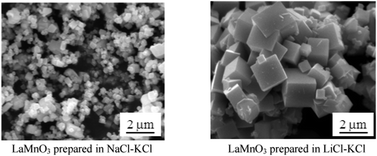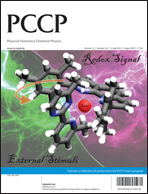LaMnO3 perovskite was successfully synthesized in molten chlorides. In order to explore the effect of the molten salt type, NaCl–KCl and LiCl–KCl eutectic mixtures were employed as a liquid medium for the perovskite formation process. The synthesis included heating the La-nitrate, Mn-nitrate and chlorides mixture to above the melting point of the corresponding chlorides. This procedure yielded a LaMnO3 phase integrated in the fused chloride matrix. Washing with water removed the salts completely, yielding pure LaMnO3 perovskite crystals. The synthesis without molten salt at 800 °C yielded several by-products in addition to the LaMnO3 phase, while with LiCl–KCl the pure perovskite phase was obtained at temperatures as low as 600 °C. Variation of temperature in the range 600–800 °C for LiCl–KCl and 700–800 °C for NaCl–KCl had no significant effect either on the morphology or on the particle size of the product. On the other hand, the effect of the molten salt type on the morphology and size of perovskite particles was remarkable. The synthesis in NaCl–KCl resulted in sub-micron LaMnO3 particles with shapes that range from truncated hexahedrons to spheres, while in LiCl–KCl mostly cubic particles of up to 2-microns were obtained. The effect of the molten salt type on LaMnO3 perovskite formation is explained based on the nucleation and crystal growth model and difference in the melting point of eutectic mixtures.

You have access to this article
 Please wait while we load your content...
Something went wrong. Try again?
Please wait while we load your content...
Something went wrong. Try again?


 Please wait while we load your content...
Please wait while we load your content...